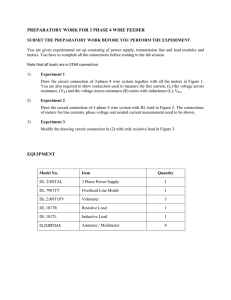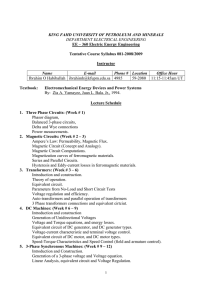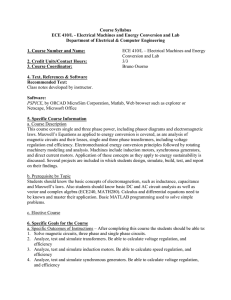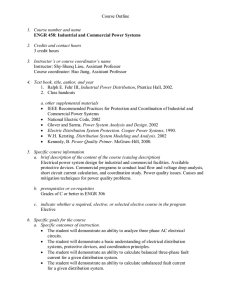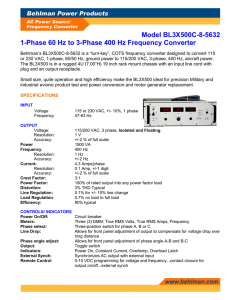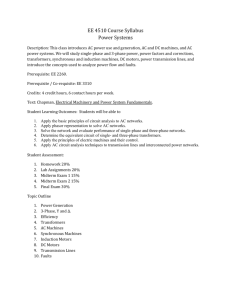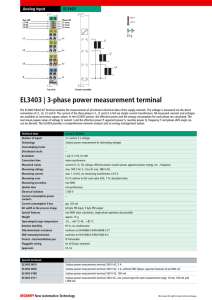EEG 208: Circuits I - Department of Electrical and Computer
advertisement
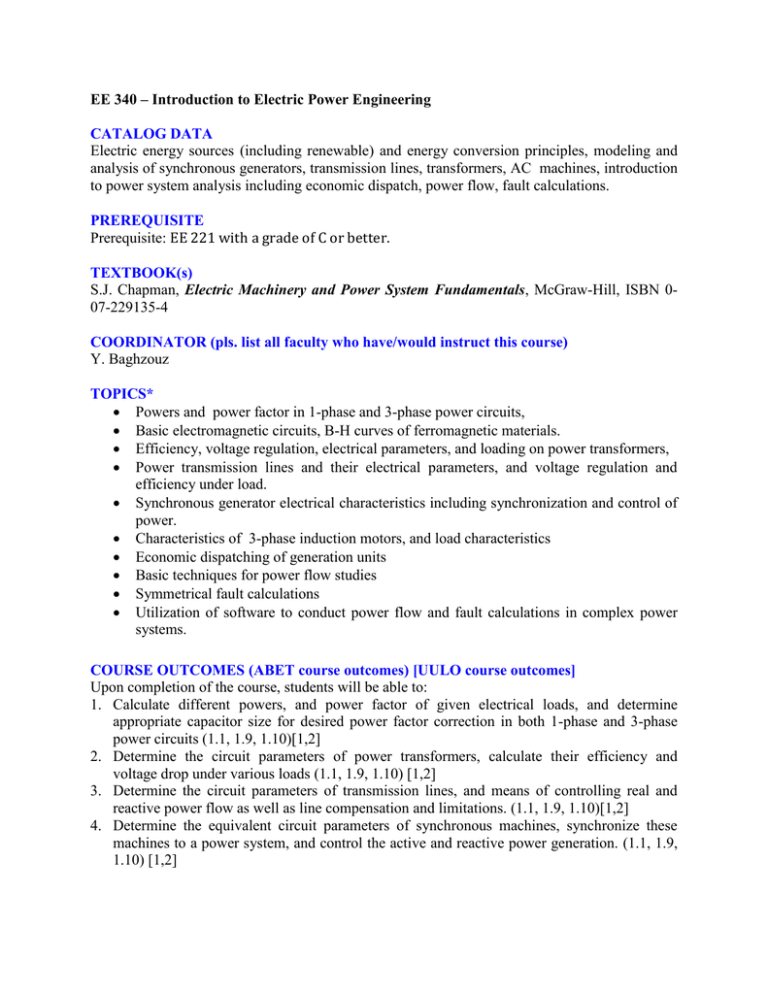
EE 340 – Introduction to Electric Power Engineering CATALOG DATA Electric energy sources (including renewable) and energy conversion principles, modeling and analysis of synchronous generators, transmission lines, transformers, AC machines, introduction to power system analysis including economic dispatch, power flow, fault calculations. PREREQUISITE Prerequisite: EE 221 with a grade of C or better. TEXTBOOK(s) S.J. Chapman, Electric Machinery and Power System Fundamentals, McGraw-Hill, ISBN 007-229135-4 COORDINATOR (pls. list all faculty who have/would instruct this course) Y. Baghzouz TOPICS* Powers and power factor in 1-phase and 3-phase power circuits, Basic electromagnetic circuits, B-H curves of ferromagnetic materials. Efficiency, voltage regulation, electrical parameters, and loading on power transformers, Power transmission lines and their electrical parameters, and voltage regulation and efficiency under load. Synchronous generator electrical characteristics including synchronization and control of power. Characteristics of 3-phase induction motors, and load characteristics Economic dispatching of generation units Basic techniques for power flow studies Symmetrical fault calculations Utilization of software to conduct power flow and fault calculations in complex power systems. COURSE OUTCOMES (ABET course outcomes) [UULO course outcomes] Upon completion of the course, students will be able to: 1. Calculate different powers, and power factor of given electrical loads, and determine appropriate capacitor size for desired power factor correction in both 1-phase and 3-phase power circuits (1.1, 1.9, 1.10)[1,2] 2. Determine the circuit parameters of power transformers, calculate their efficiency and voltage drop under various loads (1.1, 1.9, 1.10) [1,2] 3. Determine the circuit parameters of transmission lines, and means of controlling real and reactive power flow as well as line compensation and limitations. (1.1, 1.9, 1.10)[1,2] 4. Determine the equivalent circuit parameters of synchronous machines, synchronize these machines to a power system, and control the active and reactive power generation. (1.1, 1.9, 1.10) [1,2] 5. Have an understanding of the workings of three-phase AC motors, in terms of equivalent circuit parameters, and torque-speed curves, and basic load characteristics. (1.1, 1.9, 1.10) [1, 2] 6. Derive the Y-bus matrix and power flow equations of a given network and perform such a study using a software package. (1.1, 1.9, 1.10)[1, 2] 7. Solve economic dispatch problems, and calculate the short-circuit currents in a given network and perform the latter using a software package. (1.1, 1.9, 1.10) [1, 2] COMPUTER USAGE PSCAD and EASYPOWER GRADING Homework Assignments, Quizzes, Midterm, Final. ABET COURSE OUTCOMES 1. The appropriate technical knowledge and skills 1.1. An ability to apply mathematics through differential and integral calculus, 1.2. An ability to apply advanced mathematics such as differential equations, linear algebra, complex variables and discrete mathematics, 1.3. An ability to apply knowledge of basic sciences, 1.4. An ability to apply knowledge of computer science 1.5. An ability to apply knowledge of probability and statistics, 1.6. An ability to apply knowledge of engineering 1.7. An ability to design a system, component, or process to meet desired needs within realistic constraints 1.8. An ability to identify, formulate, and solve engineering problems 1.9. An ability to analyze and design complex electrical and electronic devices 1.10. An ability to use the techniques, skills, and modern engineering tools necessary for engineering practice. 1.11. An ability to design and conduct experiments, as well as to analyze and interpret data 2. The appropriate interpersonal skills 2.1. An ability to communicate effectively 2.2. An ability to function on multidisciplinary teams 3. The knowledge and skills to be responsible citizens 3.1. An understanding of professional and ethical responsibility 3.2. The broad education necessary to understand the impact of engineering solutions in a global, economic, environmental, and societal context 3.3. A recognition of the need for, and an ability to engage in life-long learning 3.4. A knowledge of contemporary issues 3.5. A knowledge of the basic content and concepts of the U.S. and Nevada constitutions UULO COURSE OUTCOMES 1. Intellectual Breadth and Lifelong Learning 2. Inquiry and Critical Thinking 3. Communication 4. Global/Multicultural Knowledge and Awareness 5. Citizenship and Ethics COURSE PREPARER AND DATE OF PREPARATION Professor Y. Baghzouz Last update date: 2/1/2015
